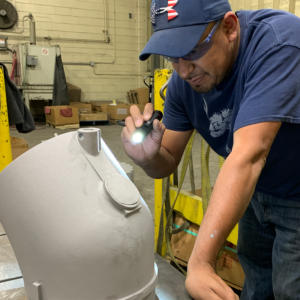Visual Inspection of Castings

Certain types of defects are obvious upon visual inspection of castings: cracked, tears, slag adhesions, blowholes, metal penetration, scabs, shifts, non-fill, cracked molds or cores and similar defects can be identified visually.
- Inspection of as-cast or cast and machined surfaces for adherence to visual acceptance standards shall be by the naked eye corrected vision in normal white light greater than customer specified footcandles /lumens without the benefit of magnification unless otherwise agreed upon between the customer and the foundry. Only in very special circumstances, however, will visual inspections be performed with more than five magnifications. Treatments such as acid etching to remove surface metal prior to inspection will not be done unless agreed upon between the customer and the Foundry.
- Acceptance for visual standards will be based upon surface appearance only, exclusive of rms or AA values and without consideration of magnetic particle, fluorescent penetrant, radiographic, or other nondestructive testing requirements for findings.
- Acceptable positive surface irregularities, as noted below, must fall within the tolerance range of the surfaces involved unless otherwise agreed upon between the customer and the Foundry. Acceptable negative surface irregularities will not be used as a reference for dimensional measurements of the surfaces involved.
Surface irregularities should be classified as follows:
- Positive surface irregularities on castings may result from excess metal caused by metal penetration into the ceramic mold material, or from air or liquid entrapment next to the pattern during the casting operation.
- Negative surface irregularities on castings may be caused by slag or oxide inclusions, gas, shrinkage, oxidation pitting or cracks.
- Positive surface defects, generally referred to as excess metal, are not potential stress raisers and acceptance evaluation usually is based upon aesthetic values, provided that tolerance requirements have been met. Negative surface irregularities may be either propagating or non-propagating. Propagating indications include visual surface cracks or cold shuts, while non-propagating indications include oxidation pitting, oxide or slag inclusions and shallow linear depressions.
Evaluation of visual standards is an area subject to differences in opinion because it is subjective and almost completely relying upon human judgment. Extremely close cooperation and agreement on mutual problems is essential between the customer and the Foundry. Standards should be based upon the widest acceptability possible.
Stainless Foundry and Engineering can produce parts to almost any quality level required by the customer. A standard should always be set up during initial phases of a program. Have a new project in hands you would like us to look through? Talk to us today.

